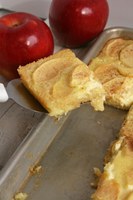Prairie Fare: Enjoy Apple Season
(Click an image below to view a high-resolution image that can be downloaded)
By Julie Garden-Robinson, Food and Nutrition Specialist
NDSU Extension
“Mom, we forgot to bring the apple picker,” my older daughter said as we stood on tiptoe next to the tree on a sunny autumn day.
An apple narrowly missed bouncing off my head as it dropped out of the tree. Yes, the apple picker would have come in handy.
We were trying to reach plump red apples from a heavily laden tree to donate to a local food pantry.
My daughter’s comment reminded me of when my children were younger, giggling among the colorful leaves as they harvested apples. Sometimes they squabbled about who was in control of the apple picker.
Back then, my daughter added padding to the inside of the apple picker basket to pluck the apples without injuring their delicate flesh.
I recall the scent of cinnamon and sweet apples cooking in the kitchen after the harvest. We used fresh apples in delicious recipes, ranging from dried apple snacks and fruit leather to desserts.
Apples are a healthful and colorful option as a snack or dessert. On average, one medium apple with skin (3 inches in diameter) is a good source of fiber, vitamins and minerals for fewer than 100 calories.
Worldwide, about 7,500 varieties exist and 2,500 can be grown in the U.S.
Apples are widely available, but are they really good for us? Many times, apples are used as the symbol of nutrition.
Apples may help protect us from heart disease and cancer, but that is true of most fruits and vegetables.
Apples are naturally cholesterol-free and low in fat and sodium. Along with several vitamins and minerals, apples provide pectin, a soluble fiber that may help reduce or maintain blood cholesterol levels. Apples also provide health-promoting antioxidant compounds, especially in the peeling.
Several researchers have conducted studies to determine if apple extracts can reduce the risk of heart disease and cancer. The results have been promising as these two research highlights show.
Researchers analyzed the diets of 34,489 women between the ages of 55 and 69 recruited from the Iowa Women’s Health Study. Amounts of flavonoids in foods were analyzed using the U.S. Department of Agriculture database because flavonoids are believed to have anti-inflammatory properties.
The researchers reported that consumption of apples, pears and several other plant-based foods was associated with a reduced risk of coronary heart disease and total cardiovascular disease mortality.
Another group of researchers studied the capacity of apple extract to reduce breast cancer using rats as an animal model. The dosage of apple extract was equal to one, three or six apples per day. They found that the number of tumors decreased with an increasing amount of the extract.
Apples are not only healthful but they are versatile ingredients. Grab a crunchy apple, rinse it well and enjoy it fresh.
Here are some other ways to make use of apples:
- Eat more whole apples than juice. When apples are processed into juice, many of the health-promoting phytochemicals decrease; therefore, nutritionists advise eating more whole fruit than juice.
- Try making applesauce. Simply chop apples and cook in water for 10 minutes. Drain water, then make applesauce or mix with honey, cinnamon and butter for a sweet side dish or dessert.
- Add apple slices to your grill. Slice apples into 1/4-inch slices and brush with butter. Place on a grill and cook until grill marks appear. Remove and top with cinnamon or honey.
- Consider drying apples. Slice apples horizontally into 1/4-inch-thick rounds. Soak apples in lemon water for 30 minutes, then pat dry. Arrange apples in a single layer on baking sheets. Add a sprinkle of cinnamon if desired. Bake for two hours at 200 F. Turn off the oven and let apples sit in the oven for one to two hours as they cool further, until desired crispiness. Or use a food dehydrator according to the manufacturer’s directions.
- Check out all the information about apples at https://www.ag.ndsu.edu/fieldtofork/choose-your-crop and go to the apple section.
Here’s a nod to the heritage of many people in the Midwest, especially in parts of North Dakota. This recipe was adapted from “Alma’s Favorite Recipes: Cooking and Memories from a German-Russian Farm Kitchen” in the Germans from Russia Heritage Collection at the NDSU Library.
Apple Kuchen Bars
7/8 c. canola oil (1 c. minus 2 Tbsp.)
1 c. sugar
2 eggs
2 c. flour
1 tsp. baking powder
1/4 tsp. salt
5 fresh apples, peeled and thinly sliced
Beat well with mixer. Put in greased jelly roll pan. Put a layer of fresh thinly sliced apples on the dough layer and then the filling.
Filling:
1 1/2 c. half and half
1 c. sugar
3 eggs
Cinnamon (sprinkle on top after baking, optional)
Bake at 350 degrees for approximately 45 minutes until custard is set and crust is lightly browned. Allow time to cool before serving. Store leftovers in the refrigerator.
Makes 28 servings. Each serving has 190 calories, 8 grams (g) fat, 2 g protein, 26 g carbohydrate, 1 g fiber and 40 milligrams sodium.
(Julie Garden-Robinson, Ph.D., R.D., L.R.D., is a North Dakota State University Extension food and nutrition specialist and professor in the Department of Health, Nutrition and Exercise Sciences. Follow her on Twitter @jgardenrobinson)
NDSU Agriculture Communication - Sept. 24, 2020
Source: Julie Garden-Robinson, 701-231-7187, julie.garden-robinson@ndsu.edu
Editor: Ellen Crawford, 701-231-5391, ellen.crawford@ndsu.edu




